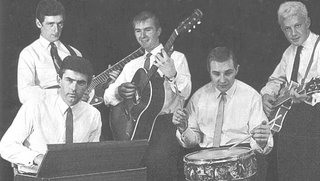To some people this sounds sophisticated, but that's only because they don't let kids into nightclubs. To me it sounds like missing the point of a classic song. Fred Astaire didn't sing it that way, and he was plenty sophisticated for a gawky looking guy.
Because a song like The Way You Look Tonight (Dorothy Fields - Jerome Kern) is romantic and has a sweet melody, it's a sitting duck for interpreters who think that means slow and dreamy.
If you listen to a lot of music from the 1930s (at the peak of what Alec Wilder called the age of The Great Innovators), you find that even the most tender of love songs could still have loads of rhythm: you could dance to them, and they kept their tenderness.
This was also the Swing Era, after all, and there was a lot of, like, swinging going on back then. (The Way You Look Tonight was first heard in a film called Swing Time.) It might've been the olden days, but they didn't spend all their time in the parlour, singing light opera ballads around the pianola.
 It's worth remembering the context of the song as Fred Astaire first sang it, in Swing Time (1936).
It's worth remembering the context of the song as Fred Astaire first sang it, in Swing Time (1936).
He and Ginger Rogers have had a tiff, and she's retired to the bathroom, shutting him out. Fred sings this meltingly lovely tribute to her, through the closed door, and she melts. In fact, she reappears, halfway through shampooing her hair.
The pace is brisk, Fred's delivery is assertive. Jerome Kern's melody conveys regret but Fred sounds positive, ready to move on but thankful just to have known her. In the studio recording the pace is enhanced by a foot-tapping rhythm section. [YouTube]
For me, this tension between regret and a more upbeat counting of your blessings is the point of the song: take out the rhythm and the song loses its backbone. And let's face it: some mournful, lovesick guy who sounds as if he's about to swoon all over the apartment floor was never gonna seduce Ginger.
In the 50s and 60s, when a rock artist took an old ballad and reworked it with a beat, it was called jazzing it up. Rockin' Rollin' Clementine was Col Joye's jazzed up version of Clementine. This sort of thing was sent up by Peter Sellers as a cockney pop star named 'Iron' (cf. Tommy Steele) who is interviewed by the BBC about his rockin' version of the Trumpet Voluntary.
And jazzing it down? That's what I call it when a fine, rhythmic song like The Way You Look Tonight is slowed down and given a lethargic jazz interpretation.
There was already a lot of this about when I was a kid in the 50s: ballad crooners, vocal groups, lush string orchestras and smoky nightclub singers, all trying hard not to sound like anything from the 30s.
My impression is that it started in the early 40s. The reasons are varied: swing bands lost personnel to the armed forces, wartime cutbacks affected touring, and the ASCAP boycott (1941) and the Musicians' Ban (1942-44) disrupted radio performances. Vocalists became the big stars and smaller comboes on independent labels got a break.
By the late 40s and early 50s, sweet, swinging records from the 30s probably sounded old-fashioned anyway, a harking back to the pre-war years and the outbreak of war. Certainly, radio in the late-40s and early 50s was full of mediocre novelty songs and cowboy music. That's what happens in pop music: things pass their use-by date.
Nowadays, though, when sophisticated jazz is mentioned, you can be sure there's a spot of jazzing it down in the offing, and it doesn't always make me melt.








